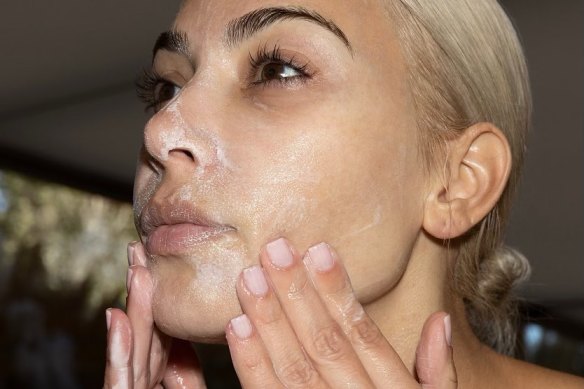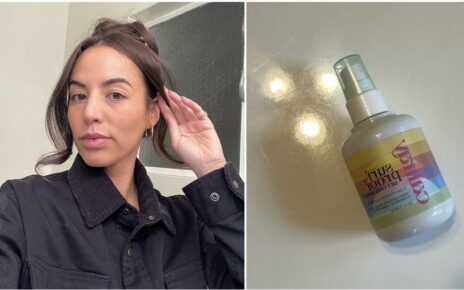If Kim Kardashian’s recently launched skincare line SKKN by Kim is anything to go by, a “perfect” skincare routine should contain no less than nine steps. You should wash your face using the SKKN Cleanser (morning and night) and follow with the exfoliator (but only two times per week). Then splash your face with a few drops of the toner before applying the hyaluronic acid serum. In the evening, follow with the vitamin C8 serum (absolutely do not apply during the day!) Don’t forget to massage on an adequate amount of face cream. To finish, tap a pea-sized amount of eye cream into the eye area (be sure to use your ring finger) before applying the oils (yes, there are two).
Are you confused yet?
Kim Kardashian’s rebrand of her previous KKW beauty line, SKKN, launched in June.Credit:SKKN/Instagram
In recent years, the beauty industry has been trending toward “skinimalism” – a stripped-back version of skincare where less is more. However, there is nothing minimal about SKKN. Kardashian’s brand takes a more is more approach, promising consumers that they too can have the 41-year-old’s picture-perfect, poreless skin if they hand over $700 and promise to dedicate 15-30 minutes a day to their new routine.
Does Kardashian herself use SKKN? Perhaps. Does she also indulge in regular Botox and facials that utilise the most high-tech anti-ageing technology known to man? Absolutely.
For your average Australian, $700 – which will last you about three months if you’re SKKNing every day – is a lot of money to spend on skincare, particularly in this economic climate. Some beauty devotees might consider it a sound investment if there is a guarantee of bright, glowing skin in the near future. But the question is: does more products equal better results? Or could a three-step skincare routine do the same thing? We ask the experts.
When did the 3-step skincare routine become 9+?
Kardashian’s range takes inspiration from South Korea where using a number of skincare products throughout the week isn’t considered unusual. This is a country where “most people start using skincare around 10 or 11 years old,” says Lauren Lee, founder of K-beauty e-store Style Story, “and might even start seeing the family facialist” around this time too.
In western media, K-beauty is famous for its 10-step skincare routine – Google “10-step skincare routine” and you’ll find over 15 million results – but as Lee explains, this concept was actually popularised by American marketers in 2014.
“There is no such thing as a 10-step skincare routine that people talk about,” Lee says. While South Koreans do take their skincare seriously, they’re more likely to pick and choose from “a whole buffet of different products to be used at different times of the year”.
While some people may opt for an intricate multi-step routine, Lee says that aiming for a certain amount of steps “isn’t necessary”. Instead, “the most important thing is to learn what works for your skin”.
Does using more products in your skincare routine equal better results?
“Our skin is a powerful organism on its own,” explains Lucy Macdougald, dermal specialist at Byron Bay-based skincare company Biologi. “It has the ability to regenerate itself so long as we’re not messing with it too much.”
“[We all have] a ‘microbiome’ which is made up of a variety of organisms that protect your skin from the outside world. Once you start introducing too many products or ingredients into your skincare regime, you risk stripping your skin of this microbiome and throwing its natural processes out of whack.”
For anyone who considers their intricate skincare routine a form of self-care, Macdougald suggests enlisting the help of an expert who “has a very thorough understanding of skincare ingredients” rather than choosing your own adventure at your local pharmacy. “When mixed together, many skincare ingredients can cancel each other out, rendering them useless, or even cause harmful reactions.”
How to build a basic skincare routine that’s right for you
After casting her eye over the SKKN range, celebrity facialist and The Modern Guide To Skin Health author Melanie Grant concedes that the brand’s offering contains a “a really well-considered collection of tried-and-true product categories” that all serve a distinct purpose.
“[There’s] hydrators to quench and plump, peptides to firm, vitamin C to brighten and shield from age-accelerating free radicals, squalene and postbiotics to promote healthy barrier function,” says Grant. “It’s a strategic but thoughtful approach – the only thing I would add is a broad spectrum SPF to be applied as the final step in your morning regimen.”
“The key is to find a handful of products that you know work for you and that you enjoy using.”
That said, if you’re reconsidering your current skincare routine, Grant says, “You’d be surprised at how much of a difference simply keeping your skin clean, hydrated and protected from the sun and environmental aggressors can make. The key is to find a handful of products that you know work for you and that you enjoy using.”
At a bare minimum, she recommends using a cleanser, moisturiser and SPF. To step it up, you could also add a targeted serum containing either “vitamin C, ferulic acid, astaxanthin, resveratrol or anti-inflammatory vitamins B and E” in the morning to brighten skin and minimise damage from pollution and the sun.
To supercharge your evening routine, you could consider “products that are more clinically active in nature like chemical exfoliants (AHA, BHA, PHA) and retinols”. These will help to speed up cell turnover and minimise fine lines and wrinkles.
But before you cut and paste your own routine together with strong active ingredients, it’s best to consult an expert, not a Kardashian. With the right tailored advice, you might find that a handful of products will do the same job as nine.
Make the most of your health, relationships, fitness and nutrition with our Live Well newsletter. Get it in your inbox every Monday.
Most Viewed in Lifestyle
From our partners
Source: Read Full Article

